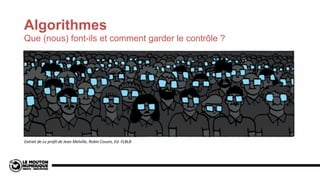
Algorithmes Que (nous) font-ils et comment garder le contrôle ?
- 1. Algorithmes Que (nous) font-ils et comment garder le contrôle ? Extrait de Le profil de Jean Melville, Robin Cousin, Ed. FLBLB
- 8. 1. Mettre la farine et les oeufs dans un saladier 2. Ajouter le lait en mélangeant 3. Cuire une louche de pâte dans une poêle avec du beurre (salé svp)
- 10. $ingrédient-1
- 11. $ingrédient-1
- 12. 1. Mettre $ingredient-1 et $ingredient-2 dans un saladier 2. Ajouter $ingrédient-3 en mélangeant 3. Cuire une louche de (résultat de étapes 1 + 2) dans $ustensile-1 avec $ingrédient-4
- 13. 1. Mettre $ingredient-1 et $ingredient-2 dans un saladier 2. Ajouter $ingrédient-3 en mélangeant 3. SI $ustensile-1 est déjà gras : a. Cuire une louche de (résultat de étapes 1 + 2) SINON : a. Déposer une mèche de $ingrédient-4 b. Puis cuire une louche de (résultat de étapes 1 + 2)
- 14. 1. Mettre $ingrédient-1 dans un saladier 2. Pour chaque $ingrédient-2 présent dans ma boite de 4 $ingrédient-2: a. Casser $ingrédient-2-X dans le saladier 3. Ajouter $ingrédient-3 en mélangeant 4. SI $ustensile-1 est déjà gras : a. Cuire une louche de (résultat de étapes 1 + 2) SINON : a. Déposer une mèche de $ingrédient-4 b. Puis cuire une louche de (résultat de étapes 1 + 2)
- 17. 1. Avec les algorithmes, c’est comme avec Lavoisier : rien ne crée, rien ne se perd, mais tout se transforme. 2. Les algorithmes sont très bêtes : ils ne savent faire que des opérations basiques (addition, soustraction…) en prenant en compte des opérations logiques : conditions ou boucles. 3. Les opérations qu’applique un algorithme ne sont pas les siennes mais celle que le développeur lui a dit d’appliquer. In fine
- 29. Oups.
- 32. Facebook fait levier sur nos biais • Biais de confirmation : désigne le biais cognitif qui consiste à privilégier les informations confirmant ses idées préconçues ou ses hypothèses (sans considération pour la véracité de ces informations) • Biais de Désirabilité Sociale: consiste a créer un environnement social qui créée une forme de pression pour pousser les utilisateurs a vouloir un produit sans qu'ils en aient nécessairement besoin • Illusion de récence : nous sommes plus sensibles aux informations récentes, ce biais implique de "faire semblant" qu'une information est nouvelle alors qu'elle est, en fait, "recyclée". • Biais de Rareté : crée une illusion de rareté pour donner une illusion d'urgence et pousser un consommateur a faire un achat
- 35. Comment Facebook choisit le contenu à afficher ? 1. Inventaire : à la connexion, l’algorithme de Facebook fait un inventaire de tout ce qui a été publié par vos amis et les pages que vous suivez 2. Signaux : Facebook analyse ensuite les milliers de données (ou signaux) à sa disposition pour prédire les publications qui vous intéressent le plus 3. Prédictions : Facebook utilise ensuite ces signaux pour faire des prédictions sur le contenu qui pourrait vous intéresser, on parle : d’un contenu que vous aimeriez lire, d’un contenu que vous trouveriez utile ou informatif, d’un contenu sur lequel vous aimeriez interagir 4. Score : Facebook classe les publications dans votre fil d’actualités. Pour ça, il leur attribue un score de pertinence (qui évalue votre intérêt supposé pour une publication)
- 39. Quelques pistes : • Actualité variée (locale, internationale) • Information recoupée à partir de différentes sources (personnes, points de vue) • Pas forcément de l’actualité chaude ni du scoop • Pas forcément destinée à vous faire réagir • Etc.
- 42. Quelques questions CC Mirko Tobias Schäfer • Comment fonctionnent les algorithmes supposés remplacer ou aider les journalistes dans certains de leurs tâches • Quels contenus vont être automatisés ? • Quel regard critique poser sur leur « efficacité » ? • Comment la profession peut-elle réagir pour ne pas « se faire dépasser » ? • Et même… • Comment le journaliste peut utiliser les algorithmes pour améliorer sa pratique ?
- 46. Mais encore ?
- 47. Comme si cela ne suffisait pas… • La presse va mal (kiosques désertés, rédactions décimées) • Défiance importante envers la profession, et les médias en général • Perte de contrôle sur la distribution des nouvelles, au profit des plateformes (et des assistants vocaux) • La « vérité » et les faits sont des notions (encore plus) relatives que jamais L’important n’est plus que les histoires soient vraies, mais que les gens cliquent • Les nouveaux médias ont aussi des biais, notamment dans le fait qu’ils favorisent des réponses très émotionnelles. Ils nous proposent d’interagir avec des choses, plutôt que de les comprendre • L’information est abondante, on parle d’ « infobésité » • Les journalistes ne sont plus les seuls producteurs de contenu, une certaine partie de la population s’y est mis • Etc. Bon courage
- 52. Fichier tabulé
- 62. 0-0 match nul Egalité match nul Victoire dans la moyenne des victoires remporté Défaite dans la moyenne des défaites vaincu Victoire dans le premier décile triomphe Défaite dans le dernier décile humiliation
- 64. Schema.org
